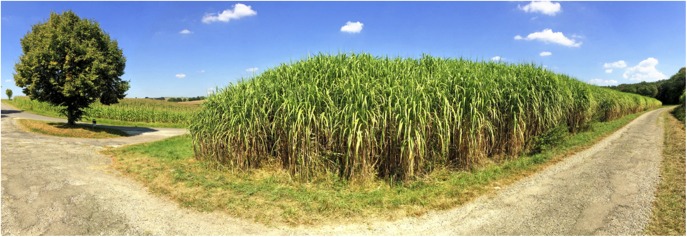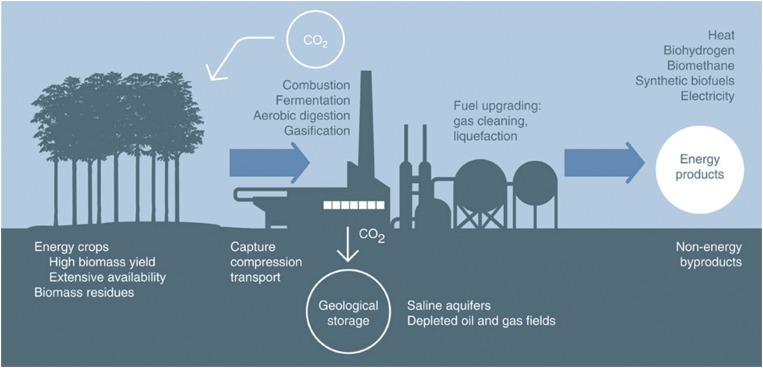Even the most optimistic models of climate change suggest a sobering reality: Making a significant dent in carbon emissions may require removing carbon from the atmosphere, not just mitigating it. “The math tells us we need carbon-removal processes of some kind,” says Julio Friedmann, Principal Deputy Assistant Secretary for the Office of Fossil Energy at the US Department of Energy.
Switchgrass is among the feedstocks being considered for new BECCS initiatives. Image courtesy of Shutterstock/hjochen.
One approach gaining traction in recent years is generating bioenergy along with carbon capture and storage, known by the acronym “BECCS.” Some argue that BECCS occupies a key role in the global plan to fight climate change. Although regarded as one of the most viable, cost-effective negative emissions technologies, there are still multiple major challenges to its widespread implementation.
At its most basic, BECCS involves growing plant material, burning that material for energy, capturing the CO2 emitted during combustion, and storing it underground. More advanced versions include gasifying easy-to-grow feedstocks, such as switchgrass, generating biofuels with algae, or even using municipal solid waste as a feedstock. BECCS has been discussed as a promising idea for years, even before a demonstration project. “It’s a modeler’s construct, not an engineer’s one,” says Roger D. Aines, Fuel Cycle Innovations Program Leader at Lawrence Livermore National Laboratory in Berkeley, California.
Cutting Carbon and Costs
One of the earliest mentions of BECCS in the literature came from Robert H. Williams of Princeton University. In 1998, when the concept was relatively new, Williams wrote a chapter for a book published by the United Nations University Press called Eco-Restructuring: Implications for Sustainable Development (1). He proposed using biomass, combined with carbon capture and sequestration, for energy generation, and calculated that the process could reduce the impacts of global warming. “In the case of biomass grown on a sustainable basis,” he wrote, “net lifecycle emissions with sequestering would be strongly negative” (1, 2).
What sets BECCS apart, potentially, is the use of a relatively clean fuel source to mop up CO2 emissions already in the atmosphere. An analysis by Daniel Sanchez, of the Carnegie Institution for Science, and Daniel Kammen, of the University of California, Berkeley, suggests the advantage of using biomass over coal could be significant. These researchers calculate that producing a megawatt-hour of electricity with coal and capturing 90% of the CO2 produced would still emit the equivalent of 182 kilograms of CO2 (also noted as 182 kgCO2eq). Using a biomass system based on switchgrass—a prairie tall-grass native to the United States—in an integrated gasification-combined cycle plant would actually remove 883 kgCO2eq from the atmosphere (3). Although no commercial power plants are currently using switchgrass, Sanchez chose it because it’s among the ideal scenarios for BECCS, those based on nonfood feedstocks that require relatively little fertilizer or water.
But BECCS faces serious cost challenges. In 2014 (the latest year available), power from wood and biomass cost an average of $4.2 per million Btu (MBtu), according to the US Energy Information Administration (4). For much of 2016, the costs of natural gas generation have been under 2 MBtu (although those costs remain volatile; in September it was under 3 MBtu) (5). Not only is biomass a relatively more expensive form of electricity than natural gas, but the costs of capturing and storing carbon are still fairly high. That’s especially true for bioenergy systems. In its BECCS fact sheet, the Center for Carbon Removal estimates that it costs $100 to capture a ton of CO2 for a biomass plant. For a comparable fossil fuel plant, capturing carbon costs just $60 a ton (6).
As carbon capture and removal is a relatively new technology, costs are likely to come down with more development. The National Energy Technology Laboratory in Pennsylvania and the Lawrence Livermore National Laboratory are among the centers working on improving BECCS through innovations, like advanced biofuels, gasification into a combustible synthetic gas (referred to as syngas), increasing plant size, and oxyfuel, a means of boosting the purity of CO2 waste by burning a fuel in the presence of pure oxygen (7).
BECCS combines energy-generating biomass with geological carbon capture and storage. This pairing, in principle, produces negative CO2 emissions. Reprinted with permission from ref. 16, with permission from Macmillan Publishers Ltd: Nature Communications, copyright (2014).
Pilot Progress
One of the few places where a BECCS plant can be seen in action on a large scale is in Decatur, Illinois, where the Arthur Daniels Midland company (ADM) has built a corn-to-ethanol plant that employs CO2 storage (8). In 2009, the US Department of Energy selected ADM as one of 12 projects to develop carbon capture and storage at an industrial scale, through its Industrial Carbon Capture and Storage program. The next year, it was one of three projects to receive continued funding (9). This year, it went into full production, capturing an estimated one million tons of carbon a year.
The plant first produces corn ethanol. Fermenting corn produces CO2 and water; the stream of gas is compressed and dehydrated to form a supercritical fluid. The supercritical CO2 is sent to a nearby injection wellhead and placed about 7,000 feet below the surface into formations with impermeable caprock but permeable formations below. This process allows the CO2 to spread out through the permeable rock, without seeping out. Slowly, over time it will start to mineralize.
The ethanol produced is sold for fuel. But the plant also hopes to make money via tax credits for CO2 sequestration (10–12) and from carbon credits created through programs, such as the low-carbon fuel standard enacted by the state of California. Carbon credits are sold in California for $120 a ton, meaning that if ADM pipes one million tons of carbon underground every year, they will reap $120 million per year in the low-carbon California fuel market.
However, it may take a few years for ADM to make money from the California fuel market. Currently, carbon credits are not sold across state lines. But they likely will be in coming years, a crucial step says Aines. “At that point, anyone selling biofuels into the California market will be able to get paid for any carbon dioxide they capture.”
Scaling Up
Enormous hurdles remain, however, and despite several dozen carbon-capture projects around the world, many say there is a serious need for additional research and large-scale demonstration projects. This year, the city of Oslo in Norway successfully tested the readiness of a waste-to-energy facility at Klemetsrud (13). The plant uses municipal solid waste to produce biofuel while capturing 90% of the produced CO2 and storing it off site.
A project based at a sugar beet refinery in Artenay, outside Orleans, France, completed its first stage this year (14). The refinery ferments sugar beets to produce alcohol for beverages, pharmaceutics, and other industrial purposes. Now they are able to capture the CO2 in the refinery’s flume and store it in the geological formation under the Paris basin.
Such BECCS projects and other carbon-removal technologies will likely have to proliferate and grow in size if countries are to have much hope of keeping warming to 1.5 °C or even 2 °C. “Coming out of the Paris Agreement, there is a bit of an elephant in the scientific discussion room right now in terms of how we meet our scientific goals,” says Deich. “The fact that our emissions trajectories aren’t coming down nearly fast enough means that we need a broad portfolio of de-carbonization technology,” Deich adds.
When it comes to BECCS, Deich says he sees both overly optimistic and overly pessimistic assessments and projections. “In my mind, it’s premature to say this as a solution is ready to go, we’ll just scale it up to massive levels,” he says. Carbon capture, BECCS or otherwise, still remains costly, and businesses lack the proper incentives. A recent editorial in Science argued that models and policies relying heavily on experimental negative emissions technologies, BECCS included, could be a recipe for disaster (15).
“The technical challenges of BECCS are real,” says Friedmann. But the bigger challenges, he says, are financial and political. “We have not yet put the policies in place that recognize the urgency of the climate challenge.”
References
- 1.Williams RH. Fuel decarbonization for fuel cell applications and sequestration of the separated CO2. In: Ayers RU, Weaver PM, editors. Eco-Restructuring: Implications for Sustainable Development. United Nations Univ Press; New York: 1998. [Google Scholar]
- 2.Hickman L. 2016 Timeline: How BECCS Became Climate Change’s ‘Saviour’ Technology. Available at https://www.carbonbrief.org/beccs-the-story-of-climate-changes-saviour-technology. Accessed September 6, 2016.
- 3.Sanchez DL, Kammen DM. A commercialization strategy for carbon-negative energy. Nature Energy. 2016;1:1–4. [Google Scholar]
- 4. US Energy Information Administration (June 2016). State Energy Data System (SEDS): 2014 (updates by energy source). Available at www.eia.gov/state/seds/seds-data-fuel-prev.cfm. Accessed September 10, 2016.
- 5. US Energy Information Administration (2014). Henry Hub Natural Gas Spot Price. Available at https://www.eia.gov/dnav/ng/hist/rngwhhdd.htm. Accessed September 10, 2016.
- 6. Center for Carbon Removal (2016). Bioenergy with Carbon Capture and Storage. Available at https://static1.squarespace.com/static/54a2e4c1e4b043bf83114773/t/56e5f312ab48de1dc3c58a0d/1457910556936/BECCS+Fact+Sheet.pdf. Accessed September 19, 2016.
- 7.Williams D. 2001. Greenhouse gas control technologies. Proceedings of the Fifth International Conference on Greenhouse Gas Control Technologies. (CSIRO Publishing, Collingwood, VIC, Australia) pp 179–184.
- 8.US Department of Energy, Office of Fossil Energy 2015 Archer Daniels Midland Illinois ICCS Project. Available at energy.gov/fe/archer-daniels-midland-company. Accessed September 6, 2016.
- 9. Global CCS Institute (2016). Illinois Industrial Carbon Capture and Storage Project. Available at https://www.globalccsinstitute.com/projects/illinois-industrial-carbon-capture-and-storage-project. Accessed September 6, 2016.
- 10.US Department of Energy, Energy Efficiency & Renewable Energy 2016 Alternative Fuels Data Center. Ethanol Fuel Basics. Available at www.afdc.energy.gov/fuels/ethanol_fuel_basics.html. Accessed September 6, 2016.
- 11. 26 US Code §45Q, Credit For Carbon Dioxide Sequestration (2016). LII/Legal Information Institute. Available at https://www.law.cornell.edu/uscode/text/26/45Q. Accessed September 6, 2016.
- 12.California Energy Commission 2016 Low Carbon Fuel Standard. Available at www.energy.ca.gov/low_carbon_fuel_standard/. Accessed September 6, 2016.
- 13.ZeroCO2.NO 2016 Klemetsrud (Oslo) waste management and energy recovery CCS project. Available at www.zeroco2.no/klemetsrud-oslo-waste-management-and-energy-recovery-ccs-project. Accessed September 19, 2016.
- 14.Techniques de l’Ingénieur 2016 Coupler stockage de CO2 et géothermie! Available at www.techniques-ingenieur.fr/actualite/articles/coupler-stockage-de-co2-et-geothermie-33438/. Accessed September 19, 2016.
- 15.Anderson K, Peters G. The trouble with negative emissions. Science. 2016;354(6309):182–183. doi: 10.1126/science.aah4567. [DOI] [PubMed] [Google Scholar]
- 16.Canadell JG, Schulze ED. 2014. Global potential of biospheric carbon management for climate mitigation. Nature Communications 5:5282.




